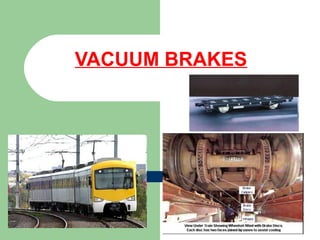
vaccumbraking-110416095553-phpapp01
- 2. PRESENTED BY: Shanu kumar UNDER THE GUIDANCE OF Dr.E.Basavaraj Professor JAWAHARLAL NEHRU NATIONAL COLLEGE OF ENGINEERING Department of Mechanical Engineering A Technical Seminar On “VACUUM BRAKES”
- 3. CONTENTS 1 INTRODUCTION 2 PRINCIPLE 3 BLOCK DIAGRAM OF VBS 4 PARTS 5 WORKING OF VBS 6 BRAKE VALVE OPEN/CLOSE 7 BRAKE RELEASED/APPLIED 8 ADVANTAGE 9 LIMITATIONS
- 4. WORLING PRINCIPLE: . The vacuum brake system is controlled through a brake pipe connecting a brake valve in the driver's cab with braking equipment on every vehicle. The operation of the brake equipment on each vehicle depends on the condition of a vacuum created in the pipe by an ejector or exhauster. The ejector, using steam on a steam locomotive, or an exhauster, using electric power on other types of train, removes atmospheric pressure from the brake pipe to create the vacuum.
- 5. BLOCK DIAGRAM OF VBS
- 6. PARTS Exhauster: It is usually controlled from the driver's brake valve, being switched in at full speed to get a brake release or at slow speed to maintain the vacuum. Brake Block: This is the friction material which is pressed against the surface of the wheel tread by the upward movement of the brake cylinder piston. Vacuum Reservoir: The operation of the vacuum brake lies on the difference in pressure between one side of the brake cylinder piston and the other. In order to ensure there is always a source of vacuum available to operate the brake, a vacuum reservoir is provided on, or connected to the upper side of the piston.
- 7. PARTS Brake Pipe: The vacuum-carrying pipe running the length of the train, which transmits the variations in pressure required to control the brake. It is connected between vehicles by flexible hoses, which can be uncoupled to allow vehicles to be separated. Ball Valve: The ball valve is needed to ensure that the vacuum in the vacuum reservoir is maintained at the required level.
- 9. BRAKE VALVE IS OPEN In a vacuum brake system, depressing the brake pedal opens a valve between the power cylinder, which contains a piston, and the intake manifold to which the power cylinder is connected. When you apply the brakes, air is exhausted from the cylinder head of the piston. At the same time, atmospheric pressure acts on the rear side of the piston to exert a powerful pull on the rod attached to the piston .
- 10. BRAKE VALVE IS CLOSED When the brake valve is closed, the chamber ahead of the piston is shut off from the intake manifold and is opened to the atmosphere. The pressure is then the same on both sides of the piston; therefore, no pull is exerted upon the pull rod. The brakes are released and the piston returned to its original position in the power cylinder by the brake shoe return springs.
- 11. BRAKE RELEASED
- 12. WHEN BRAKE IS RELEASED This diagram shows the condition of the brake cylinder, ball valve and vacuum reservoir in the release position. The piston is at the bottom of the brake cylinder. Note how the brake cylinder is open at the top so that it is in direct connection with the vacuum reservoir. A vacuum has been created in the brake pipe. The removal of atmospheric pressure from the system has caused the ball valve to open the connection between the vacuum reservoir and the brake pipe. The fall of the piston to the bottom of the brake cylinder causes the brake blocks to be released from the wheels.
- 13. BRAKE IS APPLIED
- 14. BRAKE IS APPLIED During the brake application, the vacuum in the brake pipe is reduced by admitting air from the atmosphere. As the air enters the ball valve, it forces the ball (in red in the diagram above) upwards to close the connection to the vacuum reservoir. This ensures that the vacuum in the reservoir will not be reduced. At the same time, the air entering the underside of the brake cylinder creates an imbalance in the pressure compared with the pressure above the piston. This forces the piston upwards to apply the brakes.
- 15. ADVANTAGE simple in design Ability to get partial release, something the pneumatic brake could not do without additional equipment. Greater amount of safety because the vacuum losses. Highly reliable in the case of rail wagons. Permits the automatic application of brakes down the entire length of the train from a simple control in the driver’s hand.
- 16. LIMITATIONS a very large brake piston and cylinder are required to generate the force necessary on the brake blocks The existence of vacuum in the train pipe can cause debris to be sucked in. The vacuum brake was not as effective as the air brake, it taking longer to apply and requiring large cylinders to provide the same brake effort as the air brake. It was also slow to release and requires additional equipment to speed up its operation.
- 17. CONCLUSION :- The vacuum brake was, for many years, used in place of the air brake as the standard. Because vacuum brake has the advantage of being simple in design and of having the ability to get a partial release, something the air brake could not do without additional equipment. The vacuum brake was not as effective as the air brake, it taking longer to apply and requiring large cylinders to provide the same brake effort as the air brake. It was also slow to release and requires additional equipment to speed up its operation. The vacuum brake can be apply automatic
- 19. THANKYOU….